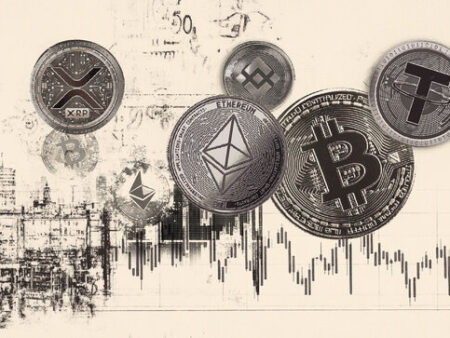XRP Navigates Sideways Trading Amid Stablecoin Liquidity Debate
XRP (Ripple) is currently struggling to gain upward momentum, consolidating around $2.17 as of Friday. Despite geopolitical tensions in the Middle East, the broader cryptocurrency market sentiment has improved. Bitcoin (BTC) has climbed above $106,000, and Ethereum is holding gains above $2,550, signaling relief for major digital assets. However, further price increases remain limited, with XRP likely to continue its consolidation phase into the weekend.
Ripple CTO David Schwartz Highlights XRP’s Role in Stablecoin Liquidity
Ripple’s Chief Technology Officer (CTO), David Schwartz, recently stated that stablecoins will not limit XRP’s potential. Instead, he emphasized that stablecoins like Ripple’s RLUSD, Tether’s USDT, and Circle’s USDC will rely on XRP’s infrastructure for liquidity.
According to Schwartz, XRP plays a crucial role in the adoption of stablecoins, particularly as a liquidity bridge.
“If you imagine dozens of stablecoins and hundreds and hundreds of markets, they probably won’t be as efficient as going through some kind of asset that aggregates like the U.S. dollar (USD) does today for smaller currencies. We see XRP playing that role,” Schwartz explained.
The movement toward a stablecoin and tokenized asset-backed economy is gaining traction in the U.S., especially with the Senate’s recent approval of the Guidance and Establishing Innovation for US Stablecoins (GENIUS) Act.
The GENIUS Act’s progress toward the House is considered a significant step toward progressive cryptocurrency regulations in the U.S.
Supporters of the bill argue that, in addition to overseeing stablecoin issuers’ operations, the GENIUS Act will ensure the smooth implementation of anti-money laundering (AML) guidelines, transaction monitoring, and customer due diligence, similar to traditional financial institutions.
Technical Outlook: XRP Extends Consolidation
XRP’s technical outlook remains uncertain, caught between support at $2.09, marked by the 200-day exponential moving average (EMA), and a confluence resistance around $2.24, established by the 100-day and 50-day EMAs.
A break above the $2.24 confluence hurdle could significantly increase the likelihood of XRP surpassing the descending trendline. Traders are watching key milestones, ranging from the May peak of $2.65 to the supply area around $3.00, which was tested as resistance in early March.
Conversely, the path of least resistance could turn downward if XRP falls below the 200-day EMA support at $2.09. Sellers already have a significant influence on the trend, with the Relative Strength Index (RSI) falling below the 50 midline.
This bearish outlook is further emphasized by the Money Flow Index (MFI), which, while remaining above the midline, indicates a slight downward trend.
The MFI tracks the amount of money flowing into XRP, with a persistent decline likely signaling a shift from bulls to bears. In that scenario, price action below the 200-day EMA could accelerate losses below $2.00, potentially leading to key levels tested in April at $1.80 and $1.61.
Cryptocurrency Metrics FAQs
What determines the total number of tokens for a cryptocurrency?
The developer or creator of each cryptocurrency decides the total number of tokens that can be minted or issued. Only a certain number of these assets can be minted through mining, staking, or other mechanisms. This is defined by the algorithm of the underlying blockchain technology. Since its creation, a total of 19,445,656 BTC have been minted, which is the circulating supply of Bitcoin. On the other hand, the circulating supply can also decrease through actions such as token burning or mistakenly sending assets to addresses of other incompatible blockchains.
What is market capitalization?
Market capitalization is the result of multiplying the circulating supply of a particular asset by its current market value. In the case of Bitcoin, the market capitalization exceeds $570 billion, which is the result of the more than 19 million BTC in circulation multiplied by the price of Bitcoin.
What is trading volume?
Trading volume refers to the total number of tokens of a specific asset that have been traded or exchanged between buyers and sellers within a set trading schedule, for example, 24 hours. It is used to measure market sentiment; this metric combines all volumes from centralized and decentralized exchanges. Increased trading volume often denotes demand for a particular asset, as more people are buying and selling the cryptocurrency.
What is the funding rate?
The funding rate is a concept designed to encourage traders to take positions and ensure that the prices of perpetual contracts match those of spot markets. It defines a mechanism of exchanges to ensure that future prices and periodic price payments converge regularly. When the funding rate is positive, the price of the perpetual contract is higher than the market price. This means that traders who are bullish and have opened long positions pay traders who are in short positions. Conversely, a negative funding rate means that the prices of perpetual contracts are lower than the reference price, so traders with short positions pay traders who have opened long positions.
Stay ahead of the curve in the fast-paced crypto world – explore the latest updates and trends at Cryptonewsfeeds.com.










